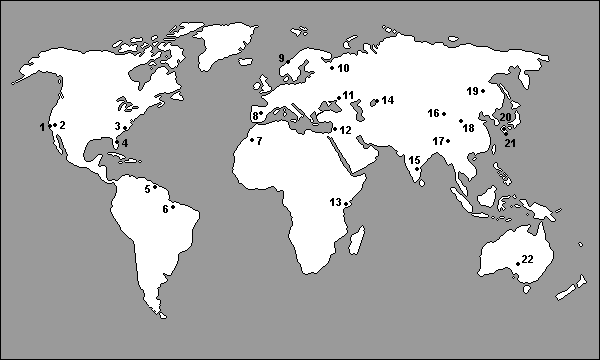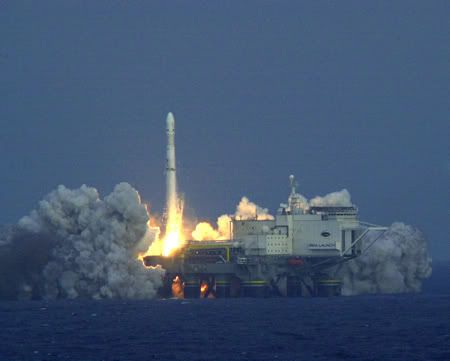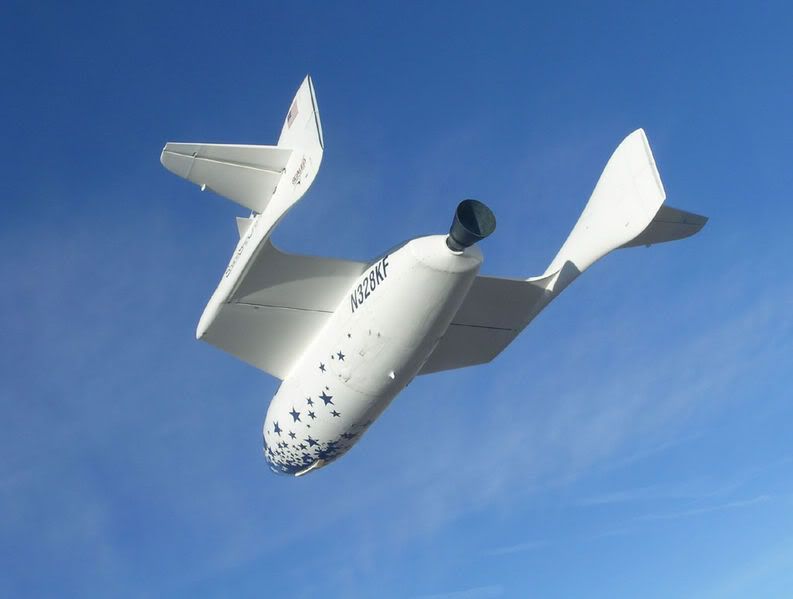|
View: 4198|Reply: 11
|
(Worlds Space Centres) [Info about SPACE TECHNOLOGY]
[Copy link]
|
|
|

1 - Vandenberg AFB
2 - Edwards AFB
3 - Wallops Island
4 - Cape Canaveral/KSC
5 - Kourou
6 - Alcantara
7 - Hammaguir
8 - Torrejon AB | 9 - Andoya
10 - Plesetsk
11 - Kapustin Yar
12 - Palmachim/Yavne
13 - San Marco Platform
14 - Baikonur/Tyuratam
15 - Sriharikota (SHAR)
| 16 - Jiuquan
17 - Xichang
18 - Taiyuan/Wuzhai
19 - Svobodny
20 - Kagoshima
21 - Tanegashima
22 - Woomera
|
[ Last edited by StellarEagle at 1-2-2007 07:00 PM ] |
Rate
-
1
View Rating Log
-
|
|
|
|
|
|
|
|
|
|
|
Sea Launch is a spacecraft launch service that uses a mobile sea platform for eaquatorial launches of commercial payloads on specialized Zenit 3SL rockets. As of January 2007 it had assembled and launched 24 rockets with two failures and one partial failure.
The sea-based launch system means the rockets can be fired from the optimum position on Earth's surface, considerably increasing payload capacity and reducing launch costs compared to land-based systems.
The Sea Launch consortium of four companies from the United States, Russia, Ukraine and Norway, was established in 1995 and their first rocket was launched in March 1999. It is managed by Boeing with participation from the other shareholders.
All commercial payloads have been communications satellites intended for geostationary transfer orbit with such customers as EchoStar, DirecTV, XM Satellite Radio, and PanAmSat.
The launcher and its payload are assembled on a purpose-built ship Sea Launch Commander in Long Beach, California. It is then positioned on top of the self-propelled platform Ocean Odyssey and moved to the equatorial Pacific Ocean for launch, with the Sea Launch Commander serving as command center. |
|
|
|
|
|
|
|
|
|
|
|

Sea Launch in Action. Payload = XM3 Satellite |
|
|
|
|
|
|
|
|
|
|
|
List of Satellites.

Source : Time Magazine |
|
|
|
|
|
|
|
|
|
|
|
Anyone else got any info about Space Tech / Rocket Science or anything related feel free to post. Sharing is Caring |
|
|
|
|
|
|
|
|
|
|
|
ORBITS
Geosynchronous orbits (GEO) are circular orbits around the Earth having a period of 24 hours. A geosynchronous orbit with an inclination of zero degrees is called a geostationary orbit. A spacecraft in a geostationary orbit appears to hang motionless above one position on the Earth's equator. For this reason, they are ideal for some types of communication and meteorological satellites. A spacecraft in an inclined geosynchronous orbit will appear to follow a regular figure-8 pattern in the sky once every orbit. To attain geosynchronous orbit, a spacecraft is first launched into an elliptical orbit with an apogee of 35,786 km (22,236 miles) called a geosynchronous transfer orbit (GTO). The orbit is then circularized by firing the spacecraft's engine at apogee.
Polar orbits (PO) are orbits with an inclination of 90 degrees. Polar orbits are useful for satellites that carry out mapping and/or surveillance operations because as the planet rotates the spacecraft has access to virtually every point on the planet's surface.
Walking orbits: An orbiting satellite is subjected to a great many gravitational influences. First, planets are not perfectly spherical and they have slightly uneven mass distribution. These fluctuations have an effect on a spacecraft's trajectory. Also, the sun, moon, and planets contribute a gravitational influence on an orbiting satellite. With proper planning it is possible to design an orbit which takes advantage of these influences to induce a precession in the satellite's orbital plane. The resulting orbit is called a walking orbit, or precessing orbit.
Sun synchronous orbits (SSO) are walking orbits whose orbital plane precesses with the same period as the planet's solar orbit period. In such an orbit, a satellite crosses periapsis at about the same local time every orbit. This is useful if a satellite is carrying instruments which depend on a certain angle of solar illumination on the planet's surface. In order to maintain an exact synchronous timing, it may be necessary to conduct occasional propulsive maneuvers to adjust the orbit.
Molniya orbits are highly eccentric Earth orbits with periods of approximately 12 hours (2 revolutions per day). The orbital inclination is chosen so the rate of change of perigee is zero, thus both apogee and perigee can be maintained over fixed latitudes. This condition occurs at inclinations of 63.4 degrees and 116.6 degrees. For these orbits the argument of perigee is typically placed in the southern hemisphere, so the satellite remains above the northern hemisphere near apogee for approximately 11 hours per orbit. This orientation can provide good ground coverage at high northern latitudes.
Hohmann transfer orbits are interplanetary trajectories whose advantage is that they consume the least possible amount of propellant. A Hohmann transfer orbit to an outer planet, such as Mars, is achieved by launching a spacecraft and accelerating it in the direction of Earth's revolution around the sun until it breaks free of the Earth's gravity and reaches a velocity which places it in a sun orbit with an aphelion equal to the orbit of the outer planet. Upon reaching its destination, the spacecraft must decelerate so that the planet's gravity can capture it into a planetary orbit.
[ Last edited by StellarEagle at 1-2-2007 08:15 PM ] |
|
|
|
|
|
|
|
|
|
|
|
Measat-1, 2 and 3 are GEO base Satellite.
our TiungSat on LEO.
RazakSAT pun on LEO. |
|
|
|
|
|
|
|
|
|
|
|
SPACE SHIP ONE and WHITEKNIGHT. -Routine Space Tourism is within reach!
Space Ship One and Whiteknight is the first non-government funded reusable SpaceCraft. Developed under Tier-1 programme by Scaled Composites. Motivated by the Ansari X-prize which is won by Tier-1 in October 2004.
-Peruntukan yang diberi ialah $20juta.
-Space Ship One is the Space Craft manakala Whiteknight MotherShip atau Jet Powered Carrier Aircraft.
-Virign Atlantic buat deal with ScaledCompostie Tier-1 to make a routing SPACE Tourism a reality.

WhiteKnight carrying Space Ship One.

Space Ship One
[ Last edited by StellarEagle at 2-2-2007 08:53 PM ] |
|
|
|
|
|
|
|
|
|
|
|
|
I'll move this thread to a more suitable board...TQ. |
|
|
|
|
|
|
|
|
|
|
|
Wah.. nice info!! |
|
|
|
|
|
|
|
|
|
| |
Category: Belia & Informasi
|